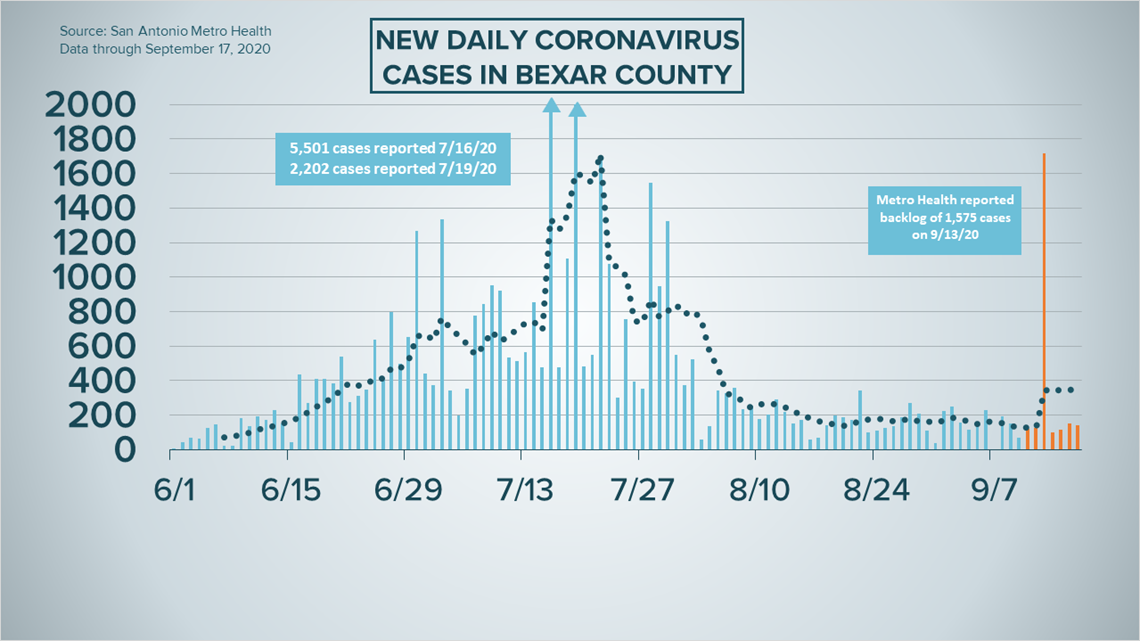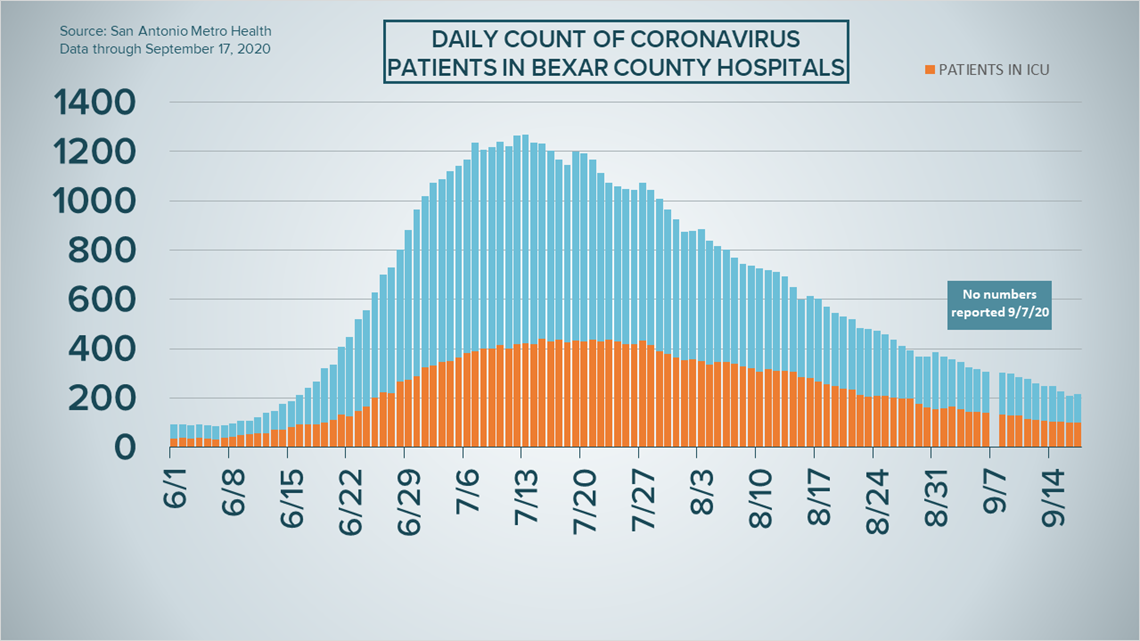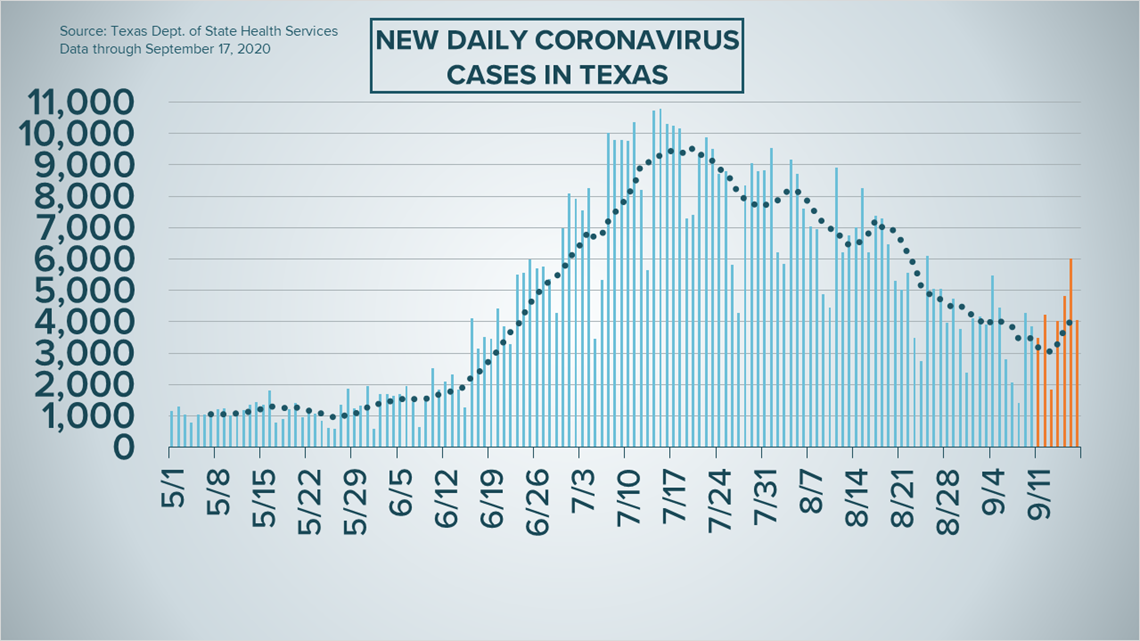SAN ANTONIO — We're tracking the latest numbers from the coronavirus pandemic in San Antonio and across Texas. Here are the latest numbers reported by Bexar and surrounding counties:
- Bexar County: 141 new cases were reported Thursday, bringing the total number for the county to 50,425. The county death toll, meanwhile, rose to 1,040 after two new fatalities were reported.
- Comal County: The county reported 10 additional cases on Thursday. No additional deaths were reported. There have been a total of 3,270 cases of COVID-19 in the county – including 2,593 confirmed cases – while 115 county residents have died. County officials say there are 313 active coronavirus cases, and 2,842 residents are considered recovered.
- Hays County: Officials in Hays County on Thursday reported 22 new cases in the county and no additional virus-related deaths. As of Thursday, there are a total of 5,719 lab-confirmed cases in the county (1,789 of which are active) while the death toll stands at 52. 3,878 residents have recovered from the virus.
How Bexar County is trending
We've tracked how many coronavirus cases have been confirmed in Bexar County from the time officials began reporting cases in March 2020. The graphic below shows the number of cases since June and charts those daily case numbers along a 7-day moving average to provide a more accurate picture of the overall coronavirus case curve in our area and the direction we're trending amid the pandemic.
On Thursday, Mayor Ron Nirenberg reported 141 new coronavirus cases in Bexar County, raising the total to 50,425 since the pandemic began.
Nirenberg reported 2 deaths on Thursday. In all, 1,040 Bexar County residents have passed away from COVID-19 complications.


Hospitalizations rose by four on Thursday, up to 214. The number of local coronavirus patients on ventilators (43) decreased slightly, while the number of patients in intensive care (100) remained unchanged.


Coronavirus in Texas
The number of Texans who have tested positive for the coronavirus since the pandemic began grew by 4,047 Thursday, according to the Texas Department of State Health Services. Of that increase, 3,518 are attributed to newly-reported coronavirus cases. Another 529 cases in the total stem from backlogs in Dallas, Harris, Montgomery, Tarrant, Collin, Camp, and Upshur counties
In total, 678,819 Texans have tested positive for COVID-19.


Meanwhile, the state also reported another 112 virus-related fatalities. In all, 14,590 Texans have died from coronavirus complications. The number of hospitalizations on Thursday dipped slightly, to 3,246; that's three fewer Texans receiving treatment for COVID-19 symptoms compared to Wednesday.
State officials estimate 594,817 Texans have recovered while 69,412 remain ill with the virus.
Thursday, Texas Governor Greg Abbott announced all Texas retail stores, restaurants, gyms, office buildings, museums and libraries can reopen at 75% capacity if cities and counties meet certain requirements.
Those businesses and buildings can reopen in the 19 hospital regions where COVID-19 hospitalizations are less than 15% of all hospitalizations, the governor said at a press conference Thursday afternoon.
Additionally, the state launched its coronavirus dashboard showing Texas public school case data.
As of Thursday afternoon, the dashboard shows 2,344 positive cases out of 1.1 million students learning in-person. DSHS says that’s less than .5 percent of the total student population who are learning in-person. The total count of on-campus staff cases during the same period is 2,175.
The data on the DSHS' website will be updated weekly on Wednesdays. Beginning Sept. 23, it will include data by school district.
Latest Coronavirus Headlines
- Texas bars must remain closed as most restaurants reopen to 75%, Gov. Abbott says
- State launches coronavirus dashboard for Texas public school case data
- Texas GOP chairman calls Gov. Abbott's actions on coronavirus 'heavy-handed'
- Moderna CEO expects to know by November if COVID-19 vaccine works
- Diez y Seis at a distance: Celebration of Hispanic Heritage Month goes virtual
- Another 860,000 filed new unemployment claims last week
- WHO calls for consistent message on coronavirus
Coronavirus symptoms
The symptoms of coronavirus can be similar to the flu or a bad cold. Symptoms include fever or chills, cough, shortness of breath or difficulty breathing, fatigue, muscle or body aches, headache, new loss of taste or smell sore throat, congestion or runny nose, nausea or vomiting and diarrhea, according to the Centers for Disease Control.
Most healthy people will have mild symptoms. A study of more than 72,000 patients by the Centers for Disease Control in China showed 80 percent of the cases there were mild.
But infections can cause pneumonia, severe acute respiratory syndrome, kidney failure, and even death, according to the World Health Organization. Older people with underlying health conditions are most at risk.
But infections can cause pneumonia, severe acute respiratory syndrome, kidney failure, and even death, according to the World Health Organization. Older people with underlying health conditions are most at risk.
Experts determined there was consistent evidence these conditions increase a person's risk, regardless of age:
- Chronic kidney disease
- COPD (chronic obstructive pulmonary disease)
- Obesity (BMI of 30 or higher)
- Immunocompromised state (weakened immune system) from solid organ transplant
- Serious heart conditions, such as heart failure, coronary artery disease, or cardiomyopathies
- Sickle cell disease
- Type 2 diabetes
The CDC believes symptoms may appear anywhere from two to 14 days after being exposed.
Human coronaviruses are usually spread...
- Between people who are in close contact with one another (within about 6 feet).
- Through respiratory droplets produced when an infected person coughs, sneezes or talks. These droplets can land in the mouths or noses of people who are nearby or possibly be inhaled into the lungs.
- Some recent studies have suggested that COVID-19 may be spread by people who are not showing symptoms.
Help stop the spread of coronavirus
- Stay home when you are sick.
- Eat and sleep separately from your family members
- Use different utensils and dishes
- Cover your cough or sneeze with your arm, not your hand.
- If you use a tissue, throw it in the trash.

